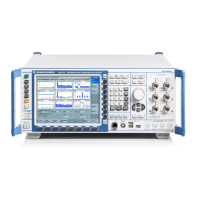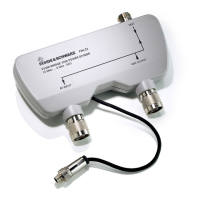System Overview
R&S
®
CMW500
73User Manual 1173.9463.02 ─ 02
The I/Q offset in dB (or dBc, according to some network standards) is the logarithmic
ratio of the I/Q offset vector (i.e. the estimated DC-offset of the measured signal) to the
average offset-corrected signal vector:
In the equation above, | Offset - corrected signal vector |
RMS
denotes the magnitude of
the offset-corrected signal vector that is RMS-averaged over all samples.
The I/Q imbalance in dB is equal to the difference between the estimated I and Q ampli-
tudes of the measured signal, which are normalized and logarithmized as follows:
From the I/Q imbalance the R&S CMW500 derives the gain imbalance and quadrature
mismatch as described in section "Measurement Results" in the description of the
"WiMAX measurement" firmware application.
The waveform quality or rho factor is a measure for the modulation accuracy and cor-
responds to the normalized correlated power between the actual waveform and the ideal
waveform sampled at the constellation points. It is defined as:
where R’
k
is the k
th
sample of the ideal signal, Z
k
is the k
th
sample of the measured signal
(both in complex representation) and the sums run over all samples. For an ideal trans-
mitter (Z
k
= R
k
for all k), the waveform quality is equal to 1. For real transmitters, the
waveform quality is a positive real number smaller than 1.
In some network applications (e.g. WCDMA), it is possible to select different algorithms
for the modulation analysis:
●
In the analysis "With Origin Offset", the modulation vectors R and Z for the EVM
calculation are measured from the origin of the I/Q plane, so the results for the EVM,
phase error and magnitude error include a possible origin offset.
●
In the analysis "Without Origin Offset", the modulation vectors R and Z for the EVM
calculation are measured from the coordinates of the I/Q offset vector, so the origin
offset is subtracted out in the EVM, phase error and magnitude error results.
4.3.7.3 Adjacent Channel Power (Spectrum)
The R&S CMW500 measures the transmitter output spectrum emissions in a symmetric
frequency range centered on the nominal RF carrier frequency. The spectrum emissions
are a measure of the amount of energy that spills outside the designated radio channel.
An excess amount of off-carrier power increases the interference with adjacent channels
and decreases the system capacity.
Measurements

